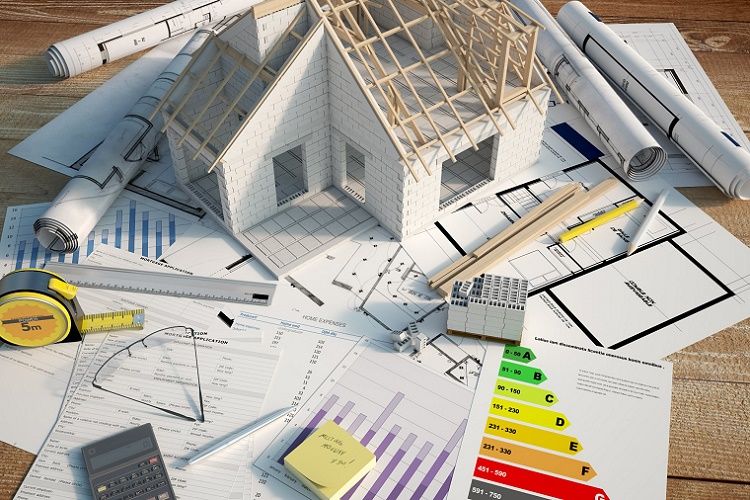How to calculate apartment land use coefficient in Vietnam?

When a project is built, architects and contractors must calculate to be able to align work items appropriately. In addition to calculating the area, size of parts, materials, the land use coefficient is also the top part. Calculating the utilization factor in addition to helping the contractor align the work items also helps the contractor save materials, offer construction plans suitable for capital. So about the matter “How to calculate apartment land use coefficient in Vietnam?” Let’s find out with LSX in the article below.
Legal grounds
- Circular 01/2021/TT-BXD
What is the land use coefficient?
In simple terms, the land use coefficient is the ratio of the total floor area to the total area of the lot. The total construction floor area will be calculated including all floor areas of the floors, except for technical floors, roof floors, basements. The land use coefficient is the ratio between the total floor area of the whole building (the unit is m2 and excluding the floor area of the basement and the roof) to the area of the entire land lot (m2)
The land use coefficient is to control the number of high floors in the construction land in proportion to the allowable construction density. For another such work, there will be a different land use coefficient as for:
• Separate house means a house built on a separate residential land plot under the lawful use right of an organization, household or individual, including villas, adjacent houses and independent houses.
• An apartment building is a house with 2 floors or more, has many apartments, has a common passageway and stairs, has a private part, a shared part and a system of infrastructure works for the common use of households. family, individual or organization.
• A multi-purpose building (or a mixed-use building) is a building with many different uses (For example, a building designed to be used as an apartment building, hotel and office is a multi-purpose building) .
• The height of a house, building or structure is the height calculated from the ground level to the highest point of the house, work or structure. For works with different ground heights, the height is calculated from the lowest ground level. How to determine the height of a house, building or structure in specific cases?
For works, the structure’s height is calculated from the height of the ground where the work is located to the highest point of the work (including the basement or the pitched roof). For works placed on the ground with different ground levels, the height is calculated from the lowest ground level. If on the top of the building there are technical equipment such as antenna poles, lightning rods, equipment using solar energy, metal water tanks, etc., the height of these devices is not included in the height of the building. Usually the height of the structure will be calculated from the ground level to the highest point of the building. For works with different ground heights, the height is calculated from the lowest ground level.
The height of the structure in some specific cases is specified as follows:
• For the pylon/tower/column structure supporting the equipment, the structure height is calculated as the sum of the height of the pylon/tower supporting the equipment and the equipment placed on the pylon/tower;
• For structures installed on existing buildings, the height of the structure is calculated from the base to the top of the installed structure (Example: a 12m long BTS pole, placed on the roof of an existing 3-storey building, the structural height of this BTS pole is calculated as 12m).
– For structures where the height of the pier is unloaded is the distance from the top of the pier to the top of the pier; Altitude above ground, water surface: Distance from cable car to ground or water surface (average water level) below
– For the pier height structure, the distances from the top surface of the pier to the top of the pier will be calculated;
– For retaining wall structure, the height of retaining wall will be calculated from the lower ground surface to the top of the wall;
– For dam structure, the dam height is calculated from the bottom of the lowest tray foot to the top of the work;
– For dam structure, from the lowest foundation after clearing the foundation (excluding the height of the tray foot) to the top of the dam.
• Number of floors of a building/work: Including all floors above ground including technical floors, mezzanines, attic floors, attic and semi-subterranean floors (Semi-subterranean floors are floors that are half the height of the building. it lies on or across the ground reinforcement where the building is located).
• Floor above ground is a floor whose floor level is higher or equal to the ground level where the work is located according to the approved planning.
• Basement (or underground floor) is a floor where more than half of its height is below the ground level where the work is located according to the approved planning.
• Half/semi-underground floor (or semi-underground floor) is a floor whose half of its height is above or equal to the ground level where the work is located according to the approved planning.
• Technical floor is the floor where the technical equipment of the building is arranged. The technical floor can be the basement, semi-basement, attic or any floor of the building.
• Attic floor is the floor located inside the space of the pitched roof, the whole or part of its façade is created by the inclined or folded roof surface, in which the vertical wall (if any) is not higher than the floor level 1, 5m.
• Number of floors of a building (or structure) includes all floors above ground (including technical floors, basement floors) and semi-basement floors, excluding attic floors.
• Buildings with attic floors are not included in the number of floors of the building when they are only used to cover stair cages or elevator wells, cover construction equipment (if any), serve the purposes of going to the roof and rescue. , whose area does not exceed 30% of the roof deck area.
• For individual houses, the mezzanine floor is not included in the number of floors of the building when the mezzanine floor area does not exceed 65% of the construction floor area of the floor immediately below.
• For buildings, house-shaped structures, multi-storey buildings with floors (excluding individual houses), the mezzanine floor is not included in the number of floors of the building when it is only arranged to be used as a technical area ( e.g. swimming pool bottom engineering floor, generator floor, or other construction equipment), whose construction floor area does not exceed 10% of the building floor area of the floor immediately below and does not exceed 300m2.
• Each building is only allowed to have one mezzanine floor, not included in the number of floors of the building
According to the actual land use index, this is an extremely important index, it shows the scale of the project, the investment cost as well as the product generated per m2 of invested land.
How to calculate apartment land use coefficient in Vietnam?
Currently, because our country’s topography is unevenly distributed such as mountains, plains, midlands, seas and islands, depending on the reality of each locality, each corresponding location and land has a coefficient of utilization. The land will be different.
When calculating the land use coefficient, it is the ratio between the total construction floor area (all floors of the floors combined, excluding technical floors, roof floors, elevator pits) to the total area of the land lot (m2).
The land use coefficient has the effect of controlling the number of high floors in the construction site in proportion to the allowable construction rate.
According to the law, according to Circular No. 03/2016/TT-BXD dated March 10, 2016 of the Ministry of Construction, the total floor area of the main building is the total floor area of all floors including area of basement, semi-basement, technical floor, roof, attic.
And the floor area of a floor is the total construction floor area of that floor including the wall, the area of the loggia, the balcony, the stairs, the elevator well, the technical box, the chimney.
According to the law, civil servants calculate the land use coefficient as follows:
Land use coefficient = Total floor area of the whole building with the area of the land lot.
In which: The floor area of the whole building will not include the area of stairs. Empty holes such as technical equipment boxes, technical floors, basements. The remaining corridors, technical floors and basements will be calculated according to another formula as prescribed by law.
• Land lot area is the total area of the whole lot in m2.
The formula for calculating the apartment land use coefficient
– Floor area ratio is the relationship between the total usable floor area a building has or is allowed to have and the total area of the lot the building has. Higher ratios may indicate an urban or dense construction. Local governments use floor area ratios for zoning codes.
Floor area ratio = Total lot area : Total building floor area
The proportion of floor area that takes up the entire floor area of a building, not simply the area of the building. Excluded from the square footage calculation are unoccupied areas such as basements, garages, stairs and elevator shafts. Buildings with different number of floors can have the same floor area ratio value. Every city has a limited capacity or limited space that can be used safely. Any use beyond this point puts undue stress on a city. This is sometimes called the safe load factor.
Floor area ratios may vary due to different population dynamics, growth patterns and construction activities, and due to the different nature of the land or space where the building is located. Industrial, residential, commercial, agricultural and non-agricultural spaces have different safety load factors, so they often have different floor area ratios. Finally, local governments establish regulations and restrictions that determine the percentage of floor space.
– Floor area ratio is the determining factor of development in any country. Low floor area ratios are generally a hindrance to construction. Many industries, mainly the real estate industry, seek to increase the percentage of floor space to expand space and land resources for developers. The increased floor area ratio allows developers to complete more construction projects, which inevitably leads to greater sales, reduced spend per project and more supply to meet demand. bridge .
Floor area ratio is the relationship of the total usable floor area of a building to the total area of the lot on which the building stands. A higher ratio usually indicates a densely populated or highly urbanized area. Floor area ratios vary according to the type of structure, such as industrial, residential, commercial, or agricultural.
– Floor area ratio not only considers the floor area of the building, but also considers the entire floor area of the building. Unoccupied areas such as garages, elevator shafts and basements are not included in the floor area ratio. Localities may have limited area or limited capacity, and use beyond that capacity puts a strain on them. It can be called the safety load factor.
– Changes in population density, construction-related activities, growth patterns, and the nature of the building’s space or land cause the FAR to change. Since the safe load factors for agricultural, residential and industrial spaces are different, the FAR is different for different spaces. Local governments establish restrictions and regulations for establishing FARs.
The floor area ratio (FAR) can also help determine the level of development in an economy. The real estate industry looks for an increase in FAR, implying that it is looking to expand land and space resources for developers.
A higher FAR allows developers to complete high-density construction projects, which, in turn, leads to increased revenue and supply and reduced cost per project. On the other hand, low FAR will limit construction works and growth. If the FAR increases, the property may become more valuable where the building is built in a way that allows for more space or more people.
– Local authorities can use the floor area ratio figure to divide land plots into zones to limit urban density. This ratio not only restricts building density, but also limits the number of people allowed into a building in the absence of control over the external appearance of the building.
– For example, suppose that the FAR is followed by a plot of 0.2. It implies that the total floor area of all floors of the buildings on the said lot should not exceed 1/5 of the lot area.
Therefore, if the lot is 15,000 square feet, the total floor area of the floors in all buildings on the plot must not be more than 3,000 square feet.
Architects can plan the allowable area consumption in either a single-story or multi-storey building. However, for the same floor area, the area of a multi-storey building must be less than the area of a single-storey building.
Services of LSX
Prestigious professional services: Firstly, the team of consultants and consultants for many years in the field of civil status, and customer support.
On-time: Certainly, with the motto “Get your lawyer right at your fingertips”, we ensure the service always performs on time. The rights and interests of customers always come first.
Cost: Besides, LSX’s service costs are highly competitive; depending on the nature of the particular case. So, we want our guests to have the best possible service experience. Therefore, costs which guaranteed to be the most suitable and economical for customers.
Confidentiality of client information: Finally, all brand information of client LSX will be 100% confidential.
Please contact us immediately if you have any questions about “How to calculate apartment land use coefficient in Vietnam?”
Contact LSX
Finally, hopefully the information in the article will provide helpful information for readers and help you solve the problem “How to calculate apartment land use coefficient in Vietnam?” At the same time, LSX Law firm always has leading lawyers and legal consultants who will help you in legal matters of life. If you have any need, please get in touch with us via hotline: +84846175333 or Email: [email protected]
Please see more
- The State recognizes the land use right in Vietnam
- Change of land use purpose in Vietnam to implement investment projects
- Is there compensation for buying planning land in Vietnam?
Frequently asked questions
The units for calculating the land use coefficient are “times” (for FAR) and “%” (for FSI). Regulations on land use coefficient are recorded in Circular 22/2019/TT-BXD of the Ministry of Construction promulgating national technical regulations on construction planning.
In this case, the land use coefficient of the apartment building is 60%. Because the land use coefficient will be equal to the number of land areas for housing. This will not include the area of stairs. Empty holes such as technical equipment boxes, technical floors, basements. The remaining corridors, technical floors and basements will be calculated according to another formula as prescribed by law.
– Land use coefficient: The ratio of the total floor area of the building including the basement (except for the floor areas serving the engineering system, fire protection, shelter and parking spaces of the building) on the total area of the lot. Floor Area Ratio (FAR) shows the correlation between the area of the lot on which the building is built and the area of the building floor that can be used or is allowed to be used. A higher floor area ratio implies a more urban or dense construction. The FAR guidelines are determined by municipalities and vary from place to place.
– Floor Area Ratio (FAR) is a measurement of the floor area of a building in relation to the size of the lot/lot in which the building is located. FAR is expressed as a decimal and is calculated by dividing the total area of the building by the total area of the parcel (building area ÷ lot area). The FAR is an efficient way to calculate the building mass or volume on a development site and is often used in conjunction with other development standards such as building height, lot coverage, and area. land plots to encourage the desired arrangement and development of the community. In this context, a higher FAR indicates a larger build volume.
Conclusion: So the above is How to calculate apartment land use coefficient in Vietnam?. Hopefully with this article can help you in life, please always follow and read our good articles on the website: lsxlawfirm.com




